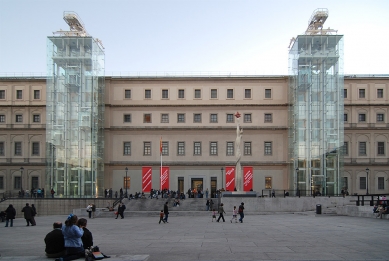
Reina Sofia Museum of Modern Art

 |
Commissioned in 1989, the project was completed in 1990. The design of the glass towers took three guiding principles:
Minimalism - The reduction of each component to a very simple form. The juxtaposition of these elements to create a rich and legible composition.
Modernity - The visible expression of current and forward-looking attitudes to design and technology.
Performance - In addition to ensuring effective movement for thousands of visitors a day, the aim is to achieve a degree of transparency that reduces visual impact from outside and allows uninterrupted views from inside, both when waiting and, more spectacularly, when riding in the lifts - a pause to make visual contact and re-orientate yourself with the world outside the museum.
Picasso’s “Guernica” was the inspiration behind the design’s composition of flat surfaces and planes.
We felt that the towers should have a didactic rô le, and hence we chose to hang the glass from the outside, and to resist horizontal wind loads from within. This would allow the public a better chance to understand how the construction works, and at the same time give people the opportunity to touch key elements of the architecture.
Given the demands of a rapid programme, the glazing method uses an established and tested system of glass fixing. The method of suspension is more innovative, but uses simple components designed to allow easy monitoring of quality and rapid manufacture in the quantities required.
Ian Ritchie Architects
0 comments
add comment




















